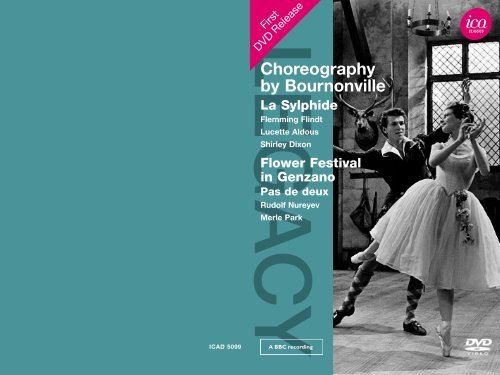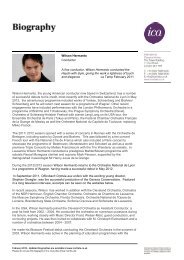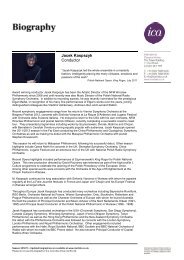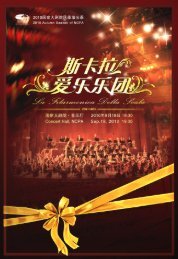to download - International Classical Artists
to download - International Classical Artists
to download - International Classical Artists
Sie wollen auch ein ePaper? Erhöhen Sie die Reichweite Ihrer Titel.
YUMPU macht aus Druck-PDFs automatisch weboptimierte ePaper, die Google liebt.
First<br />
DVD Release<br />
Choreography<br />
by Bournonville<br />
La Sylphide<br />
Flemming Flindt<br />
Lucette Aldous<br />
Shirley Dixon<br />
Flower Festival<br />
in Genzano<br />
Pas de deux<br />
Rudolf Nureyev<br />
Merle Park<br />
ICAD 5099
1 Introduction <strong>to</strong> ICA Classics 2.58<br />
LA SYLPHIDE<br />
The Sylph · Die Waldfee<br />
Choreography: August Bournonville<br />
Music: Herman Severin Løvenskiold<br />
James . . . . . . . . . . . . . . . . . . . . . . . . . . . . . . . . . . . . . . . . . . . . . . . . . . . Flemming Flindt<br />
a young farmer · un jeune fermier · ein junger Bauer<br />
The Sylph . . . . . . . . . . . . . . . . . . . . . . . . . . . . . . . . . . . . . . . . . . . . . . . . . Lucette Aldous<br />
la Sylphide · die Waldfee<br />
Effie . . . . . . . . . . . . . . . . . . . . . . . . . . . . . . . . . . . . . . . . . . . . . . . . . . . . . . .Shirley Dixon<br />
James’s fiancée · la fiancée de James · James’ Verlobte<br />
Gurn . . . . . . . . . . . . . . . . . . . . . . . . . . . . . . . . . . . . . . . . . . . . . . . . . . . . John Chesworth<br />
a farmhand · un paysan · ein Landarbeiter<br />
Madge . . . . . . . . . . . . . . . . . . . . . . . . . . . . . . . . . . . . . . . . . . . . . . . . . . . Gillian Martlew<br />
a witch · une sorcière · eine Hexe<br />
Anna . . . . . . . . . . . . . . . . . . . . . . . . . . . . . . . . . . . . . . . . . . . . . . . . . . . . . . Valerie Marsh<br />
James’s mother · la mère de James · James’ Mutter<br />
Nancy . . . . . . . . . . . . . . . . . . . . . . . . . . . . . . . . . . . . . . . . . . . . . . . . . . . . . Jennifer Kelly<br />
Effie’s friend · une amie d’Effie · eine Freundin von Effie<br />
Ballet Rambert<br />
London Symphony Orchestra<br />
Leader: Norman Nelson<br />
David Ellenberg<br />
Act One · Acte un · Erster Akt<br />
2 Opening titles 1.03<br />
3 Scène: James asleep 0.55<br />
4 The sylph appears 2.45<br />
5 James awakes and spies the sylph 0.46<br />
6 Entrance of Gurn 0.39<br />
7 Entrance of Effie 1.03<br />
8 Entrance and dance of the friends 2.13<br />
9 Scène: Madge and the fortune telling 4.22<br />
10 James, alone, and reappearance of the sylph 4.08<br />
11 Scène: James, Gurn and the sylph 1.34<br />
12 Arrival of the guests 2.57<br />
13 James and Effie: pas de deux with the corps 3.26<br />
14 Scène and finale of Act 1: James, the sylph and Effie 2.51<br />
Act Two · Acte deux · Zweiter Akt<br />
15 Scène: Madge, the witches and the magic scarf 2.04<br />
16 Scène (the forest glade): James, the sylph and her companions 2.15<br />
17 Grand pas: James, the sylph and the corps 9.28<br />
18 Scène: James, the sylph, Gurn and Effie 2.43<br />
19 Gurn proposes <strong>to</strong> Effie and is accepted 0.54<br />
20 Scène: James, Madge and the magic scarf 1.53<br />
21 Pas de deux: the sylph and James 3.29<br />
22 Death of the sylph 3.14<br />
23 Scène and finale: ascension of the sylph and death of James 2.20<br />
24 Closing credits 2.15<br />
Producer: Margaret Dale<br />
Designer: Lionel Radford<br />
Recorded: BBC Studio, London, 31 January & 2 February 1961<br />
Broadcast: BBC, 2 April 1961<br />
© BBC 1961<br />
2<br />
3
FLOWER FESTIVAL IN GENZANO (Pas de deux)<br />
La Fête des fleurs à Genzano · Blumenfest in Genzano<br />
Choreography: August Bournonville<br />
Music: Matthias Strebinger<br />
arr. Holger Simon Paulli<br />
Paolo . . . . . . . . . . . . . . . . . . . . . . . . . . . . . . . . . . . . . . . . . . . . . . . . . . . . Rudolf Nureyev<br />
a young man · un jeune homme · ein junger Mann<br />
Rosa . . . . . . . . . . . . . . . . . . . . . . . . . . . . . . . . . . . . . . . . . . . . . . . . . . . . . . . . . Merle Park<br />
a young woman · une jeune femme · eine junge Frau<br />
Orchestra of the Royal Opera House<br />
Ashley Lawrence<br />
Producer: Patricia Foy<br />
Recorded: Sadler’s Wells Theatre, 15 December 1974<br />
Broadcast: BBC, 27 December 1974<br />
© BBC 1974<br />
25 Pas de deux 11.26<br />
BONUS<br />
LA SYLPHIDE<br />
The Sylph · Die Waldfee<br />
For a free promotional DVD sampler including highlights from the<br />
ICA Classics DVD catalogue, please email info@icaclassics.com.<br />
For ICA Classics<br />
Executive Producer: Stephen Wright<br />
Head of DVD: Louise Waller-Smith<br />
Production Executive: Aurélie Baujean<br />
Executive Consultant: Ernie Gilbert<br />
ICA Classics gratefully acknowledges the assistance of Rosalind Bentley (Rudolf Nureyev Foundation) and Merle Park.<br />
DVD Studio Production<br />
DVD Design & Development: msm-studios GmbH<br />
Studio Producer: Johannes Müller<br />
Screen Design: Hermann Enkemeier<br />
DVD Authoring & Video Encoding: Benjamin Fritz<br />
Audio Postproduction & Encoding: Chris<strong>to</strong>ph Stickel & Philip Lewis<br />
Video Postproduction: Michael Hartl<br />
Project Management: Herbert Fraungruber<br />
DVD Packaging<br />
Product Management: Cat Gill & Harry Robson for WLP Ltd<br />
Booklet Editing: Laura Sandford for WLP Ltd<br />
Introduc<strong>to</strong>ry Note & Translations © 2013 <strong>International</strong> <strong>Classical</strong> <strong>Artists</strong> Ltd<br />
Cover Pho<strong>to</strong>: © V & A Images<br />
Art Direction: Georgina Curtis for WLP Ltd<br />
2013 BBC, under licence <strong>to</strong> <strong>International</strong> <strong>Classical</strong> <strong>Artists</strong> Ltd<br />
Licensed courtesy of BBC Worldwide<br />
The sound on this DVD has been improved with Enhanced Mono. During the remastering of this original mono programme,<br />
the audio signal has been res<strong>to</strong>red <strong>to</strong> give a wider and more open sound which, though not equivalent <strong>to</strong> a stereo recording,<br />
improves the quality of the original source and provides a richer sound experience.<br />
Choreography: August Bournonville<br />
Music: Herman Severin Løvenskiold<br />
James . . . . . . . . . . . . . . . . . . . . . . . . . . . . . . . . . . . . . . . . . . . . . . . . . . . Flemming Flindt<br />
a young farmer · un jeune fermier · ein junger Bauer<br />
The Sylph . . . . . . . . . . . . . . . . . . . . . . . . . . . . . . . . . . . . . . . . Elsa-Marianne von Rosen<br />
la Sylphide · die Waldfee<br />
Pro Arte Orchestra<br />
Leader: Max Salpeter<br />
Carmen Dragon<br />
Producer: Charles R. Rogers<br />
Recorded: BBC Studio, London, 10 July 1960<br />
Broadcast: BBC, 16 July 1960<br />
© BBC 1960<br />
ICA CLASSICS is a division of the management agency <strong>International</strong> <strong>Classical</strong> <strong>Artists</strong> Ltd (ICA). The label features archive material<br />
from sources such as the BBC, WDR in Cologne and the Bos<strong>to</strong>n Symphony Orchestra, as well as performances from the agency’s own<br />
artists recorded in prestigious venues around the world. The majority of the recordings are enjoying their first commercial release.<br />
The ICA Classics team has been instrumental in the success of many audio and audiovisual productions over the years, including<br />
the origination of the DVD series The Art of Conducting, The Art of Piano and The Art of Violin; the archive-based DVD series<br />
Classic Archive; co-production documentaries featuring artists such as Richter, Fricsay, Mravinsky and Toscanini; the creation of<br />
the BBC Legends archive label, launched in 1998 (now comprising more than 250 CDs); and the audio series Great Conduc<strong>to</strong>rs<br />
of the 20th Century produced for EMI Classics.<br />
WARNING: All rights reserved. Unauthorised copying, reproduction, hiring, lending, public performance and broadcasting<br />
prohibited. Licences for public performance or broadcasting may be obtained from Phonographic Performance Ltd.,<br />
1 Upper James Street, London W1F 9DE. In the United States of America unauthorised reproduction of this recording<br />
is prohibited by Federal law and subject <strong>to</strong> criminal prosecution.<br />
Act Two · Acte deux · Zweiter Akt<br />
26 Pas de deux 7.04<br />
4<br />
Made in Austria<br />
5
BOURNONVILLE AND LA SYLPHIDE<br />
To the extent that La Sylphide was a refutation of the classically academic ballets of the early<br />
nineteenth century, it has rightly been regarded as the first ‘romantic’ ballet. Certainly, the narrative of<br />
La Sylphide, replete with airy winged wraiths, a malevolent witch, unrequited love, murder and treachery,<br />
embraces many of the themes coursing through the romantic literature of its time. Given the<br />
innocence of its principal characters, La Sylphide is also one of the saddest of ballets. The loss of<br />
innocence, a recurring theme in the arts of the romantic era, establishes the emotional arc of the work.<br />
The s<strong>to</strong>ry, set in Scotland, involves a farmer, James, who, while asleep, is visited by a sylph who,<br />
enamoured of the young man, dances around him but vanishes when he awakes. James’ fiancée, Effie,<br />
arriving with the wedding party, finds James distracted. When they leave, the sylph materialises before<br />
James expressing her love. When Effie returns, James, forgetting his encounter with the sylph, is about<br />
<strong>to</strong> slip a ring on<strong>to</strong> Effie’s finger when the sylph reappears, and snatching the ring from James’s hand,<br />
places it on her own finger and rushes in<strong>to</strong> the forest. Smitten anew by the sylph, James follows.<br />
In the forest glade, we first see Madge, whom James had earlier ejected from his house. Bent on<br />
revenge, Madge, a witch, is conjuring up a diaphanous and deadly magic scarf from the depths of a<br />
boiling cauldron. The scene shifts <strong>to</strong> a glade where the sylph and James dance with the sylph’s<br />
companions. The wedding guests who followed James in<strong>to</strong> the woods arrive at the glade. Gurn, a<br />
friend of James and Effie, is urged by Madge <strong>to</strong> propose <strong>to</strong> Effie since James clearly has other romantic<br />
interests. Effie accepts Gurn’s proposal. When they have left, Madge gives James the scarf, telling<br />
him that wrapping it around the sylph will bind their love. When James enfolds her in the scarf she<br />
shudders and dies in his arms. As James sees her borne aloft by her sister sylphs, he falls lifeless.<br />
The first version of La Sylphide premiered in Paris on 12 March 1832 with choreography by Filippo<br />
Taglioni designed <strong>to</strong> showcase the considerable talents of his daughter, Marie. The ballet was an<br />
international sensation, captivating audiences in France, London, Berlin and Russia. The Danish<br />
choreographer, August Bournonville, mindful of the great success of the work, planned a revival of<br />
La Sylphide for his Royal Danish Ballet, but the Paris Opéra, rights holder for the music, demanded<br />
<strong>to</strong>o high a price for its use. Bournonville, ever the pragmatist, decided <strong>to</strong> mount his own version<br />
instead, commissioning a new score from Herman Severin Løvenskiold. Apparently there were no<br />
rights restrictions regarding the ballet’s libret<strong>to</strong>, for Bournonville’s La Sylphide follows the narrative<br />
thread of Taglioni’s original closely. Bournonville’s setting of the ballet premiered in Copenhagen on<br />
28 November 1836. It was for decades the crown jewel of the Royal Danish Ballet’s reper<strong>to</strong>ire and is<br />
still performed regularly by the company.<br />
Other notable productions of the ballet include Petipa’s 1892 revival of the Taglioni original with<br />
additional music by Riccardo Drigo for the Russian Imperial Ballet, and, in 1972, an attempted recreation<br />
of the Taglioni setting by Pierre Lacotte for the Paris Opera Ballet. Lacotte based his version<br />
of La Sylphide on prints, drawings and other materials from the period of the ballet’s premiere. An<br />
authentic version of La Sylphide has remained an elusive quest. Dance notation was non-existent<br />
at the time and notes on contemporary performances were sparse, so the Ballet Rambert 1961<br />
telecast of the ballet presented here has no irrefutable claim <strong>to</strong> authenticity. Still, what we regard as<br />
the ‘Bournonville style’ seems very much evident in the dancing of the soloists in this production.<br />
The most salient characteristic of Bournonville’s choreography is quick footwork performed<br />
effortlessly with lightness and buoyancy. Even at its most virtuosic level, the dancing should appear<br />
understated. Épaulement (relationship of the head and shoulders <strong>to</strong> the working foot) is done with<br />
natural grace and harmony. Mime, an important element of the style, should present the ballet’s<br />
narrative with utmost clarity.<br />
On all these counts, this performance achieves its goals, emphatically in the casting of Flemming<br />
Flindt and Lucette Aldous who dance the roles of James and the sylph. One of Bournonville’s lasting<br />
contributions <strong>to</strong> the art of ballet was <strong>to</strong> elevate the importance of the male dancer. At the time, the<br />
men generally served <strong>to</strong> support the ballerina and were given scant opportunity <strong>to</strong> display their<br />
skills. Flindt’s James demonstrates just how well Bournonville succeeded in giving his male dancers<br />
greater prominence. In his second-act solo, Flindt’s mastery of batterie (the beating <strong>to</strong>gether of the<br />
legs in the air) is nothing short of dazzling and, in the best Bournonville style, brought off with<br />
seeming effortlessness.<br />
While Flindt was a product of the Danish school and fully immersed in Bournonville’s work, Aldous,<br />
a native of Australia, was a member of Ballet Rambert and had little experience with Bournonville’s<br />
ballets. Still, her airy jumps and the lightness of her movements suit the choreography splendidly<br />
and her portrayal of the doomed sylph is genuinely moving.<br />
For a 1960 performance of the second-act pas de deux from La Sylphide, included here, Flindt is<br />
joined by the Swedish ballerina Elsa-Marianne von Rosen. A product of the Swedish school, she is<br />
best known as the crea<strong>to</strong>r of the title role of Cullberg’s Miss Julie, a sex-fuelled contemporary work,<br />
far from the world of La Sylphide, a ballet which she set for several companies in her native Sweden<br />
and elsewhere. She is also credited for the staging seen on this performance by Ballet Rambert.<br />
Here, again, Flindt as<strong>to</strong>nishes with a series of perfectly executed, elevated entrechats six.<br />
Aside from La Sylphide, Bournonville is best known for his Flower Festival in Genzano, almost<br />
entirely through its featured pas de deux which, apart, from the ballet, remains the choreographer’s<br />
most widely travelled work. It is a favourite for dancers entering international competitions and<br />
frequently finds a featured spot in company galas. For the BBC ‘Gala Performance’ series, its<br />
producer secured Rudolf Nureyev and Merle Park for a glittering display of this charming bauble.<br />
One might quibble at Nureyev’s more muscular approach <strong>to</strong> the choreography, but he’s at the <strong>to</strong>p of<br />
his game and for most of us that is quite enough. Park, on the other hand, displays her Bournonville<br />
credentials in a lilting performance suffused with gaiety and teasing playfulness.<br />
Ernie Gilbert<br />
6<br />
7
BOURNONVILLE ET LA SYLPHIDE<br />
Dans la mesure où La Sylphide <strong>to</strong>urne le dos aux ballets académiques du début du XIX e siècle,<br />
elle est considérée à juste titre comme le premier ballet “romantique”. Sans aucun doute,<br />
l’argument, avec ses créatures ailées fantasques, sa sorcière malveillante, son cocktail d’amour<br />
non payé de re<strong>to</strong>ur, de meurtre et de traîtrise, embrasse bien des thèmes de la littérature romantique<br />
de l’époque. Vu l’innocence de ses protagonistes, La Sylphide est aussi l’un des ballets les<br />
plus tristes. La perte de l’innocence, un sujet récurrent dans les arts romantiques, dessine l’arc<br />
émotionnel de l’œuvre.<br />
L’argument est situé en Écosse. James, un paysan, est visité dans son sommeil par une sylphide qui<br />
l’aime et danse au<strong>to</strong>ur de lui, mais elle disparaît lorsqu’il s’éveille. Effie, la fiancée de James, arrive<br />
pour les noces et trouve le jeune homme distrait. Tandis qu’elle va se préparer pour le mariage, la<br />
Sylphide se matérialise devant James et lui exprime son amour. Effie revient, et James, oubliant sa<br />
rencontre avec la Sylphide, s’apprête à lui glisser une alliance au doigt, mais la Sylphide réapparaît,<br />
arrache l’alliance des mains de James, la met à son propre doigt et s’enfuit dans la forêt. À nouveau<br />
fasciné par la créature fantasque, James la suit.<br />
Dans une clairière au milieu de la forêt, on découvre la sorcière Madge, que James avait auparavant<br />
chassée de chez lui. Préparant sa vengeance, Madge fait apparaître des profondeurs d’un chaudron<br />
rempli d’une mixture bouillante un voile diaphane aux propriétés mortelles. Changement de tableau :<br />
dans une clairière, James danse avec la Sylphide et ses sœurs. Les invités de la noce qui ont<br />
suivi James dans les bois arrivent à la clairière. Madge presse Gurn, un ami de James et Effie, de<br />
demander la main d’Effie puisque James a apparemment d’autres vues. Effie accepte d’épouser<br />
Gurn. Une fois qu’ils sont partis, Madge donne à James le voile magique et lui explique qu’en<br />
enveloppant la Sylphide dans ce voile il scellera leur amour. James s’exécute, la Sylphide est alors<br />
prise d’un frissonnement et meurt dans ses bras. Tandis que ses sœurs l’emmènent dans les airs,<br />
James s’effondre sans vie.<br />
La première version de La Sylphide, qui fut créée à Paris le 12 mars 1832 avec une chorégraphie<br />
de Filippo Taglioni, avait été conçue pour mettre en valeur le talent exceptionnel de la fille du<br />
chorégraphe, Marie. Le ballet fit sensation et conquit le public dans le monde entier, notamment en<br />
France, à Londres, à Berlin et en Russie. Devant l’énorme succès de l’œuvre, le chorégraphe danois<br />
August Bournonville projeta de la monter avec son Ballet royal du Danemark, mais l’Opéra de Paris,<br />
détenteur des droits sur la musique, exigea un prix trop élevé pour l’utilisation de la partition. En bon<br />
pragmatiste, Bournonville décida de faire représenter sa propre version et commanda une nouvelle<br />
partition à Herman Severin Løvenskiold. Il n’y avait apparemment pas de problèmes de droits<br />
concernant l’argument, car La Sylphide de Bournonville suit de près le fil narrateur de l’original de<br />
Taglioni. La version de Bournonville fut présentée à Copenhague le 28 novembre 1836. Pendant des<br />
dizaines d’années, elle fut le joyau du réper<strong>to</strong>ire du Ballet royal du Danemark et elle continue d’être<br />
donnée régulièrement par cette compagnie.<br />
Parmi les autres productions remarquables de La Sylphide figurent celle montée en 1892 par Petipa<br />
avec le Ballet impérial de Russie, où l’original de Taglioni avait été augmenté de plusieurs numéros<br />
musicaux de Riccardo Drigo, et celle donnée en 1972 à l’Opéra de Paris, avec laquelle Pierre Lacotte<br />
tenta de reconstituer la production originale de Taglioni en s’appuyant sur les gravures, les dessins<br />
et autres documents contemporains de la création du ballet. Une version authentique de La Sylphide<br />
demeure cependant une u<strong>to</strong>pie. Un système universel de notation de la danse n’existait pas à cette<br />
époque et les commentaires sur les représentations d’alors sont rares. Ainsi, la version que l’on voit<br />
ici avec le Ballet Rambert, une télédiffusion de 1961, ne saurait prétendre à une parfaite authenticité.<br />
Pour autant, ce qui est considéré comme le “style Bournonville” apparaît de manière manifeste dans<br />
la danse des solistes.<br />
L’aspect le plus caractéristique de la chorégraphie de Bournonville sont des jeux de jambe rapides<br />
exécutés sans effort, avec légèreté et entrain. Même à son niveau le plus virtuose, la danse doit<br />
paraître sobre. Les épaulements (effacement d’une épaule vers l’arrière en avançant l’autre vers le<br />
public) sont faits avec naturel, grâce et harmonie. Le mime, un élément important du style, doit<br />
présenter le récit avec la plus grande clarté.<br />
À <strong>to</strong>us ces points de vue, cette chorégraphie atteint son but, et avec brio dans la distribution emmenée<br />
par Flemming Flindt (James) et Lucette Aldous (la Sylphide). L’un des apports fondamentaux de<br />
Bournonville à l’art du ballet fut de donner plus d’importance au danseur masculin. À l’époque, les<br />
hommes servaient en général de faire-valoir à la ballerine et n’avaient que de rares occasions de<br />
déployer leur talent. Le James de Flindt montre à quel point Bournonville a réussi à conférer aux<br />
danseurs un rôle de premier plan. Dans son solo du deuxième acte, il maîtrise les batteries (mouvement<br />
de jambes qui s’entrecroisent pendant que le danseur est en l’air) de manière éblouissante et, dans<br />
le meilleur style Bournonville, s’en acquitte apparemment sans le moindre effort.<br />
Si Flindt, un produit de l’école danoise, était complètement immergé dans l’œuvre de Bournonville,<br />
Aldous, une Australienne membre du Ballet Rambert, avait peu d’expérience dans ce domaine. Pour<br />
autant, ses sauts et la légèreté de ses mouvements conviennent parfaitement à la chorégraphie et<br />
son portrait de la Sylphide vouée à l’échec est authentiquement émouvant.<br />
Est également repris ici le pas de deux du deuxième acte dans une version de 1960 où Flindt a pour<br />
partenaire la Suédoise Elsa-Marianne von Rosen. Représentante de l’école suédoise, Rosen est<br />
connue notamment pour être la créatrice du rôle-titre de Miss Julie de Birgit Cullberg, une œuvre<br />
contemporaine très sexuelle bien loin de l’univers de La Sylphide – elle monta cependant ce ballet<br />
pour diverses compagnies en Suède et ailleurs, et on lui doit également la version présentée ici<br />
avec le Ballet Rambert. Ici encore, Flindt éblouit avec une série d’entrechats six vertigineux,<br />
parfaitement exécutés.<br />
Bournonville est également connu pour sa Fête des fleurs à Genzano, notamment le pas de deux de<br />
l’œuvre qui demeure le morceau du chorégraphe le plus fréquemment monté en dehors de<br />
8 9
La Sylphide. C’est un numéro prisé par les danseurs se présentant à des concours internationaux et<br />
il trouve fréquemment sa place dans les galas des compagnies de danse. Pour l’émission de la BBC<br />
Gala Performance, le producteur invita Rudolf Noureïev et Merle Park qui donnent une interprétation<br />
étincelante de cette charmante babiole. On pourra chicaner sur l’approche musculaire de Noureïev,<br />
mais il est au sommet de son art et pour la plupart d’entre nous, c’est <strong>to</strong>ut à fait suffisant. Park, de<br />
son côté, décline son Bournonville dans une exécution enlevée qui est imprégnée de gaieté et d’un<br />
ludisme malicieux.<br />
Ernie Gilbert<br />
Traduction : Daniel Fesquet<br />
BOURNONVILLE UND LA SYLPHIDE<br />
La Sylphide stand in starkem Kontrast zu den Konventionen klassischer akademischer Ballette<br />
des frühen 19. Jahrhunderts und ist richtigerweise als erstes “romantisches” Ballett bezeichnet<br />
worden. Die in La Sylphide erzählte Geschichte beinhaltet sphärische geflügelte Waldgeister, eine<br />
boshafte Hexe, unerwiderte Liebe, Mord und Betrug; alles Themen, die in dieser Zeit in der<br />
romantischen Literatur verbreitet waren. Gleichzeitig ist La Sylphide aufgrund der Unschuld der<br />
Hauptcharaktere auch eines der traurigsten Ballette. Der Verlust der Unschuld, ein in der Kunst der<br />
Romantik häufig anzutreffendes Thema, bestimmt den emotionalen Spannungsbogen des Werkes.<br />
Die Handlung spielt in Schottland. Der Bauer James wird im Schlaf von einer Sylphe besucht, die<br />
sich in ihn verliebt und um ihn herumtanzt, jedoch verschwindet, sobald er aufwacht. Dann betreten<br />
James’ Verlobte Effie und die Hochzeitsgesellschaft die Szene und Effie findet James zerstreut<br />
vor. Als sie wieder gegangen sind, erscheint die Sylphe erneut und gesteht James ihre Liebe. Effie<br />
kehrt zurück und James vergisst seine Begegnung mit der Sylphe. Er ist gerade dabei, Effie einen<br />
Ring an den Finger zu stecken, als die Sylphe erneut erscheint, James den Ring aus der Hand<br />
reißt, ihn sich selbst ansteckt und in den Wald eilt. James wird aufs Neue in den Bann der Sylphe<br />
gezogen und folgt ihr.<br />
Auf der Waldlichtung sieht man Madge, die James vorher seines Hauses verwiesen hatte. Madge ist<br />
auf Rache aus und zaubert einen durchscheinenden und tödlichen magischen Schal aus den Tiefen<br />
ihres brodelnden Kessels hervor. Szenenwechsel zu einer anderen Lichtung, auf der James und die<br />
Sylphe gemeinsam mit den Gefährten der Sylphe tanzen. Die Hochzeitsgäste, die James in den Wald<br />
gefolgt sind, erreichen die Waldlichtung. Gurn, ein Freund von James und Effie, wird von Madge<br />
gedrängt, Effie einen Heiratsantrag zu machen, da James eindeutig andere romantische Absichten<br />
verfolgt. Effie akzeptiert Gurns Antrag und sie gehen. Madge überreicht James den Schal und teilt<br />
ihm mit, dass er die Liebe der Sylphe an sich binden könne, indem er den Schal um sie wickle. Als<br />
James den Schal um die Sylphe schlägt, erschaudert sie und stirbt in seinen Armen. James sieht,<br />
wie sie von ihren Sylphengeschwistern emporgetragen wird, und auch er sackt leblos zusammen.<br />
Die erste Version von La Sylphide wurde am 12. März 1832 in Paris mit einer Choreographie<br />
von Filippo Taglioni uraufgeführt, deren Augenmerk darauf lag, das beachtliche Talent seiner<br />
Tochter Marie zu präsentieren. Das Ballett entwickelte sich zu einer internationalen Sensation<br />
und zog das Publikum in Frankreich, London, Berlin und Russland in seinen Bann. Der<br />
dänische Choreograph August Bournonville plante angesichts dieses großen Erfolges eine<br />
Wiederaufführung von La Sylphide mit seinem Königlich Dänischen Ballett, doch die Pariser<br />
Oper, welche die Rechte an der Musik besaß, verlangte einen zu hohen Preis für die Nutzung.<br />
Bournonville entschied mit für ihn typischer Pragmatik, eine eigene Version aufzuführen, und<br />
gab bei Herman Severin Løvenskiold eine Neukomposition in Auftrag. Anscheinend gab es<br />
keine rechtlichen Beschränkungen, was das Libret<strong>to</strong> des Werkes anging, denn Bournonvilles<br />
La Sylphide hält sich eng an den Erzählfaden des Taglioni’schen Originals. Bournonvilles<br />
Inszenierung des Balletts wurde am 28. November 1836 in Kopenhagen uraufgeführt. Es war<br />
über Jahrzehnte das Kronjuwel im Reper<strong>to</strong>ire des Königlich Dänischen Balletts und wird immer<br />
noch regelmäßig von der Kompanie aufgeführt.<br />
Zu weiteren bemerkenswerten Produktionen des Balletts gehören Petipas Neuaufführung<br />
des Taglioni-Originals mit dem Kaiserlich-Russischen Ballett im Jahre 1892 mit zusätzlicher<br />
Musik von Riccardo Drigo sowie 1972 Pierre Lacottes Versuch einer Rekonstruktion der<br />
ursprünglichen Taglioni-Inszenierung mit dem Ballett der Pariser Oper. Lacotte basierte seine<br />
Version von La Sylphide auf Drucken, Zeichnungen und anderen Materialien aus der Zeit der<br />
Premiere des Balletts. Eine authentische Version von La Sylphide zu produzieren, ist eine<br />
schwer zu erfüllende Aufgabe. Zur damaligen Zeit gab es noch keine Tanznotation und<br />
Beschreibungen zeitgenössischer Aufführungen sind rar gesät. Die Fernsehaufzeichnung<br />
des Stückes mit dem Ballett Rambert von 1961 kann also keinen Anspruch auf völlige<br />
Authentizität erheben. Doch nichtsdes<strong>to</strong>weniger wird das, was man als “Bournonville-Stil”<br />
kennt, im Tanz der Solisten in dieser Produktion deutlich.<br />
Die hervorstechendste Eigenschaft von Bournonvilles Choreographiestil ist die schnelle<br />
Fußarbeit, die mit Leichtigkeit und Schwung ausgeführt wird. Selbst auf virtuosestem Niveau<br />
sollte das Tanzen wie beiläufig wirken. Das Épaulement (die Bewegung, die das Verhältnis des<br />
Kopfes und der Schultern zum Fuß des Spielbeins bestimmt) erfolgt mit natürlicher Anmut<br />
und Harmonie. Die Mimik, ein wichtiges Stilelement, sollte die im Ballett erzählte Geschichte<br />
klar zum Ausdruck bringen.<br />
Diese Aufführung erfüllt eindeutig alle der genannten Anforderungen, besonders durch die<br />
Besetzung von Flemming Flindt und Lucette Aldous als James und die Sylphe. Ein bleibender<br />
Beitrag Bournonvilles zur Ballettkunst war, dass er dem männlichen Tänzer mehr Wichtigkeit<br />
verlieh. Zur damaligen Zeit dienten Männer generell nur der Unterstützung der Ballerina und sie<br />
erhielten selten Gelegenheit, ihr eigenes Können unter Beweis zu stellen. Flindts James zeigt,<br />
wie gut es Bournonville gelungen war, seine männlichen Tänzer mehr ins Rampenlicht zu<br />
rücken. Flindts Meisterschaft der batterie (des Aneinanderschlagens der Beine in der Luft) in<br />
10 11
seinem Solo im zweiten Akt ist schlicht atemberaubend und wird, im besten Bournonville-Stil,<br />
scheinbar mühelos ausgeführt.<br />
Also available on DVD and digital <strong>download</strong>:<br />
Flindt entstammte der dänischen Schule und war völlig mit Bournonvilles Arbeit vertraut. Aldous<br />
hingegen kam aus Australien, war ein Mitglied des Ballet Rambert und hatte nur wenig Erfahrung<br />
mit Bournonvilles Balletten. Nichtsdes<strong>to</strong>weniger passen ihre luftigen Sprünge und die Leichtigkeit<br />
ihrer Bewegungen hervorragend zur Choreographie und ihre Darstellung der dem Tode geweihten<br />
Sylphe ist wirklich bewegend.<br />
Den auf dieser DVD enthaltenen pas de deux aus dem zweiten Akt von La Sylphide in der Aufführung<br />
von 1960 tanzt Flindt gemeinsam mit der schwedischen Ballerina Elsa-Marianne von Rosen. Sie<br />
gehört der schwedischen Schule an und ist am besten bekannt für ihre Darstellung der Titelrolle<br />
in Cullbergs Miss Julie, einem zeitgenössischen, deutlich sexuellen Stück, das weit entfernt von<br />
der Welt von La Sylphide scheint, einem Ballett, das sie für mehrere Kompanien in ihrer Heimat<br />
Schweden und in anderen Ländern inszenierte. Auch für die hier veröffentlichte Inszenierung mit<br />
dem Ballet Rambert war sie verantwortlich. Wieder einmal verblüfft Flindt mit einer Reihe perfekt<br />
ausgeführter, hoher entrechats six.<br />
Außer für La Sylphide ist Bournonville auch für das Blumenfest in Genzano sehr bekannt, beinahe<br />
ausschließlich aufgrund des enthaltenen pas de deux, der, losgelöst vom restlichen Stück,<br />
das meistaufgeführte Werk des Choreographen ist. Der pas de deux ist besonders beliebt bei<br />
Tänzern, die damit an internationalen Wettbewerben teilnehmen, und wird häufig bei Galas der<br />
Tanzkompanien aufgeführt. Für die Reihe “Gala Performance” der BBC engagierte der Produzent<br />
Rudolf Nurejew und Merle Park, die dieser charmanten Spielerei bei ihrem Auftritt besonderen<br />
Glanz verliehen. Man mag vielleicht Nurejews eher muskelbasierten Choreographieansatz<br />
bemängeln, doch er ist in absoluter Höchstform und das erscheint durchaus ausreichend. Park<br />
wiederum zeigt ihre Bournonville-Qualitäten mit einer beschwingten Darbietung voller Heiterkeit<br />
und neckischer Verspieltheit.<br />
Ernie Gilbert<br />
Übersetzung: Leandra Rhoese<br />
ICAD 5030<br />
Les Sylphides · Giselle<br />
Svetlana Beriosova · Violetta Elvin<br />
Alicia Markova · John Field<br />
Nadia Nerina · Nikolai Fadeyechev<br />
Niels Bjørn Larsen · Lydia Sokolova<br />
Margaret Hill<br />
ICAD 5040<br />
John Cranko<br />
The Lady and the Fool · Pineapple Poll<br />
Svetlana Beriosova · Ray Powell · Ronald Hynd<br />
Merle Park · David Blair · Stanley Holden<br />
Brenda Taylor · Gerd Larsen<br />
Orchestra of the Royal Opera House<br />
London Symphony Orchestra · Charles Mackerras<br />
ICAD 5041<br />
Mahler: Symphony No.5<br />
London Philharmonic Orchestra<br />
Klaus Tennstedt · Diapason d’or<br />
ICAD 5042<br />
Schumann: Symphony No.4<br />
Mahler: Das Lied von der Erde<br />
Carolyn Watkinson · John Mitchinson<br />
BBC Philharmonic Orchestra<br />
Kurt Sanderling<br />
12<br />
13
ICAD 5043<br />
Schubert: Symphony No.9 ‘Great’<br />
Schumann: Symphony No.4<br />
Wagner: Good Friday Music from Parsifal<br />
Bos<strong>to</strong>n Symphony Orchestra<br />
Erich Leinsdorf<br />
ICAD 5044<br />
Schubert: String Quartets Nos.10 & 12<br />
Brahms: String Quartet No.2<br />
Borodin Quartet<br />
ICAD 5051<br />
Mahler: Symphony No.1<br />
Richard Strauss: Till Eulenspiegel<br />
Bos<strong>to</strong>n Symphony Orchestra<br />
Erich Leinsdorf<br />
ICAD 5052<br />
Schumann: Genoveva Overture<br />
Symphony No.2<br />
Schubert: Symphony No.5<br />
Bos<strong>to</strong>n Symphony Orchestra<br />
Charles Munch · Diapason d’or<br />
ICAD 5049<br />
Bruckner: Symphony No.5<br />
BBC Symphony Orchestra<br />
Günter Wand<br />
ICAD 5050<br />
Tchaikovsky: Ballet Masterpieces<br />
Extracts from Sleeping Beauty, Swan Lake<br />
and The Nutcracker<br />
Margot Fonteyn · Michael Somes<br />
ICAD 5056<br />
Haydn: String Quartet in C ‘Emperor’<br />
Mozart: String Quartet in C K465<br />
Amadeus Quartet<br />
ICAD 5057<br />
Handel: Water Music Suite<br />
Mozart: Symphony No.36 ‘Linz’<br />
Symphony No.38 ‘Prague’<br />
Bos<strong>to</strong>n Symphony Orchestra<br />
Charles Munch<br />
14<br />
15
ICAD 5059<br />
Beethoven: Egmont Overture<br />
Tchaikovsky: Symphony No.5<br />
Bos<strong>to</strong>n Symphony Orchestra<br />
Erich Leinsdorf · Diapason d’or<br />
ICAD 5064<br />
Mendelssohn: Symphony No.4 ‘Italian’<br />
Britten: Les Illuminations<br />
Handel · Beethoven<br />
Academy of St Martin in the Fields<br />
Sir Neville Marriner<br />
ICAD 5067<br />
Haydn: Symphony No.55<br />
Beethoven: Symphonies Nos.7 & 8<br />
Bos<strong>to</strong>n Symphony Orchestra<br />
William Steinberg · Diapason d’or<br />
ICAD 5071<br />
Bruckner: Symphony No.8<br />
Bos<strong>to</strong>n Symphony Orchestra<br />
William Steinberg<br />
ICAD 5065<br />
Berlioz: Le Corsaire – Overture<br />
Tchaikovsky: Manfred Symphony<br />
Elgar · Prokofiev<br />
St Petersburg Philharmonic Orchestra<br />
Yuri Temirkanov<br />
ICAD 5066<br />
Bruckner: Symphony No.7<br />
Bos<strong>to</strong>n Symphony Orchestra<br />
Klaus Tennstedt<br />
ICAD 5072<br />
Mahler: Symphony No.4<br />
Mozart: Symphony No.35 ‘Haffner’<br />
Bos<strong>to</strong>n Symphony Orchestra<br />
Klaus Tennstedt<br />
ICAD 5073<br />
Chopin: Ballade No.3 · Scherzo No.3<br />
Fantasy in F minor<br />
Beethoven: Piano Sonata No.23<br />
‘Appassionata’ · Piano Sonata No.32<br />
Van Cliburn · Claudio Arrau<br />
16 17
ICAD 5074<br />
Treasures of the Russian Ballet<br />
Galina Ulanova · Maya Plisetskaya<br />
Vladimir Vasiliev · Ekaterina Maximova<br />
Yuri Soloviev · Maris Liepa<br />
Raisa Struchkova<br />
ICAD 5058<br />
Les Sylphides · Coppélia<br />
Giselle (extract)<br />
Nadia Nerina · Robert Helpmann<br />
Margot Fonteyn · Rudolf Nureyev<br />
ICAD 5025<br />
Tchaikovsky: Rococo Variations · Pezzo<br />
capriccioso · Romeo and Juliet Overture<br />
Britten: Gloriana (extracts)<br />
Peter Pears · The Aldeburgh Festival Singers<br />
English Chamber Orchestra<br />
Mstislav Rostropovich · Benjamin Britten<br />
ICAD 5088<br />
La Fille mal gardée<br />
Nadia Nerina · David Blair<br />
Stanley Holden · Sir Frederick Ash<strong>to</strong>n<br />
ICAD 5082<br />
Stravinsky: The Rite of Spring<br />
Sibelius: Symphony No.5<br />
London Symphony Orchestra<br />
Leonard Bernstein<br />
Diapason d’or<br />
ICAD 5083<br />
Mozart: Symphony No.40<br />
Britten: Nocturne<br />
Mendelssohn: Symphony No.3<br />
‘Scottish’ (extracts)<br />
Peter Pears · English Chamber Orchestra<br />
Benjamin Britten<br />
ICAD 5089<br />
Mendelssohn: A Midsummer Night’s<br />
Dream – Overture<br />
Brahms: Symphony No.1<br />
Chicago Symphony Orchestra<br />
Sir Georg Solti<br />
ICAD 5097<br />
Bruckner: Symphony No.7<br />
Chicago Symphony Orchestra<br />
Sir Georg Solti<br />
18<br />
19
















